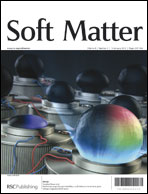One-pot morphogen driven self-constructing films based on non-covalent host–guest interactions†
Abstract
The construction of films with complex architectures through one-pot reactions taking place exclusively on a surface remains a challenge. Recently, to address this problem, we introduced a concept based on morphogen-driven film buildup. We used Cu(I) as morphogen and the Huisgens click-reaction between azide and alkyne groups on


 Please wait while we load your content...
Please wait while we load your content...